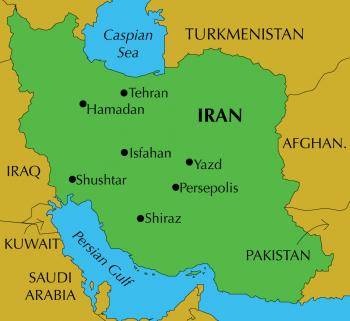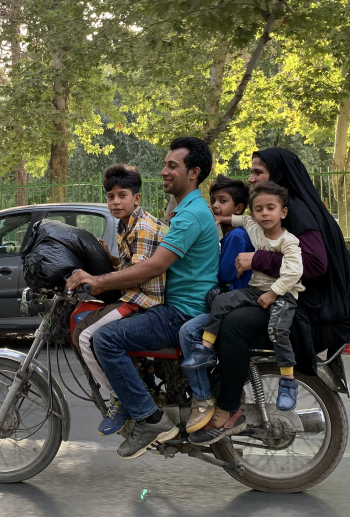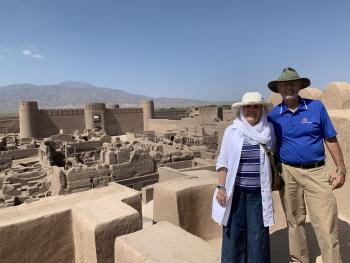A wonder-filled tour of Iran
This article appears on page 6 of the October 2020 issue.
After a 15-hour flight from San Francisco, via Dubai, on Emirates airline, my husband, Bill, and I arrived in Tehran, Iran. This was the beginning of our 3-week September 2019 tour with JMG Tibet Tours (Lauderhill, FL; 866/548-4238, www.jmgtibettours.com).
Though I don’t enjoy writing, I really felt compelled to share this amazing experience because so many of my preconceptions were wrong.
About the tour
This was owner Jeff Garrett’s first venture taking a tour group to Iran. There were 11 of us, including Jeff, all Americans.
We had traveled with JMG Tibet Tours to both the Caucasus and the Five ’Stans, so our decision to travel with Jeff again was an easy one. This being an inaugural tour, I thought we might run into some glitches, but that was not the case.
As we landed, all the ladies who were not already wearing head coverings put their scarves on. Wearing a head covering is obligatory for all women in the Islamic Republic of Iran. I had worried that we might be under the watchful eye of some kind of fashion police, but I never felt like that.
Our tour price of $4,195 per person, double, included four internal flights — Ahvaz to Shiraz, Shiraz to Kerman, Tehran to Mashhad and Mashhad back to Tehran. We stayed in excellent hotels, and a few, like the Dad in Yazd, with its magnificent central courtyard, stood out. The hotel was like a tourist attraction in itself!
The very well located Alvas Movin in Mashhad, easy walking distance from the incredible Holy Shrine, is also worth mentioning, but my favorite was the Ariana Traditional Hotel in Kashan. It had been the home of a wealthy merchant and had a beautiful courtyard and rooms with stained-glass windows and canopied beds.
The dinner there was also my favorite, but don’t ask me what we ate; it was really all about the strawberry milkshake drizzled with chocolate syrup.
The 11 of us plus our guide, Mahdieh, traveled in a 40-plus passenger bus complete with WiFi. This being a first-time tour in Iran, I was concerned that we might get a guide whose English would be barely translatable, but Mahdieh (pronounced Media), a lovely young woman, was bilingual, with beautiful English. She was also independent, renovating a home in the old part of Yazd, which we visited.
As Americans (as was true for Brits and Canadians), we were restricted from wandering on our own, but Mahdieh let us know immediately that she would gladly accompany us anywhere we wanted to explore. She’d stay with us even after 10 p.m. if we were still out and about.
Iran was clean, the roads were excellent, and we could drink the water. The tour gave us a great taste of the many Irans — modern Iran, historical Persia and Shia Islamic Iran. There were so many ancient sites, from the Tomb of Cyrus near Pasargadae to the ancient city of Persepolis.
Tehran to Shiraz
In week one, we traveled from Tehran to Hamadan and on to Kerman, Shushtar, Susa, Ahvaz and Shiraz.
In Tehran, we toured the former American Embassy, which is now a museum. The guide there was very welcoming and well informed.
The amazing Golestan Palace, a UNESCO World Heritage Site, was over the top, rivaling palaces I’ve seen in Russia. Small mirrors seemed to be the decoration of choice throughout Iran, and we felt as though we were inside a crystal. Just breathtaking!
Also, though it was not on our itinerary, Mahdieh got us into the National Jewelry Treasury, which houses the crown jewels and the amazing, jewel-covered Peacock Throne. The security there was extremely tight, and I felt very fortunate to see these national treasures.
At Hamadan, we viewed the Ganjnameh Inscriptions, cuneiform writings situated high on a mountainside, and at Shushtar we visited another UNESCO Site, an ancient hydraulic system.
When we left our hotel in Shushtar, the employees sprinkled rose water on our exit path — an ancient tradition bidding us safe travels and hopes that we would return in the future.
In Shiraz, we visited beautiful gardens, the Nasir al-Mulk Mosque (aka the Pink Mosque) and the Karim Khan Citadel, plus much more.
Religious sites
From Shiraz, we drove to the historical city of Persepolis, built by Darius the Great in about 515 BC. The thing that stays with me most about our visit there is Mahdieh’s historical knowledge about the ceremonies that were held there and the carvings on the Apadana (audience hall).
Not far from Persepolis, we saw the necropolis of Naqsh-e Rustam (reminiscent of Petra in Jordan), where Darius and Xerxes are entombed.
We traveled to Rayen and Bam to see two mud-brick citadels. The one at Bam is a Unesco Site, although Rayen was equally impressive.
We ended our second week in Yazd. This is Mahdieh’s hometown, and she was justifiably proud of it.
It is the Zoroastrian center of Iran, something I was very much interested in learning about. Good thoughts, good words and good deeds are, as it was explained, the core of their philosophy.
We visited a Tower of Silence, used for the Zoroastrian death ritual of exposing the dead to scavenging birds of prey to aid in decomposition, practiced up until 60 years ago. Then we went to a Fire Temple, sacred to the Zoroastrians.
Isfahan was next up, and it is a jewel in the crown of Iran.
One thing I’ve neglected to say is that a major component of the country’s architecture is the beautiful tile work that covers palaces, garden walls and mosques. This was prevalent in Isfahan’s Ali Qapu Palace.
Isfahan is also the place to see many beautiful handicrafts, which I discovered at the Qeisarieh Bazaar (Grand Bazaar) that surrounds Imam Square, the second-largest public square in the world.
We took a morning walk to the city’s Armenian quarter and its cathedral. In addition, there was a quite good museum there displaying ancient Christian artifacts. Then our group paused for tea and coffee in one of the many area coffee shops.
On our drive between Kashan and Qom, we took a short drive off the main road to Abyaneh, a unique mountain town also known as “the red village” because of the iron-oxide-filled soil that is used to make the local homes.
With only a few hundred people, the village differed from other areas we visited because the women all wore traditional clothing. Also, it was the only place the ladies seemed camera-shy.
We did not neglect the Islamic sites of Iran, visiting several mosques, including in Qom and Mashhad. We actually met with clerics on two occasions. The mosque in Mashhad, glittering with mirrors and colorful tiles, was the most spectacular.
Reflections
One thing I learned on this trip is that Sept. 1 is not the ideal time of year to visit Iran. It was HOT! One day, when touring a ziggurat, it was 117°F. The plus side was we had every outdoor site to ourselves.
Jeff handled the lengthy visa process for us, which started at the end of January for our September trip.
One lasting memory I will certainly take with me is of the friendliness of the people we met. We were consistently asked where we were from, and we would hesitantly say “California,” thinking they might not know that that was in the US. The response was “America. Really?!” and then “Welcome, welcome. We love Americans.” Their expressions of surprise happened over and over again.
People offered to guide us around and invited us to their homes. I had the feeling that while we were there, we were the only Americans in Iran.
People said how brave we were, knowing the negativity we were hearing about their country in the States. What came after that was much picture taking and gathering their families around for even more photos.
We happened to be there during the month of Muharram, a month of mourning (for Shia) for the grandson of Mohammed. This is a huge occurrence. People dress in black, for the most part, and black banners are hung everywhere.
On Ashura, the 10th day of Muharram, huge displays of mourning go on, with men and boys filling the streets, flagellating themselves with chains.
During this time, almost everything is closed, but that didn’t stop Mahdieh. She had us right in the thick of things.
I did wonder a bit about the wisdom of this, but people kept warmly greeting us and taking and posing for pictures. It’s a time for giving food, throwing candy and passing out water, and one lady even ran after me to give me a cucumber. What a memory!
This was not just a sightseeing tour but an in-depth cultural experience.



